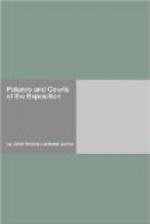I have taken the liberty of culling the chief ideas from the article on the subject, written for the November “International Studio,” adding a few ideas which seem consistent with the work before us.
-
This fountain, done in pierced relief, is most decorative in the Court of the Ages. It is, from a technical standpoint, a most remarkable composition.
-
The next subject for study is The Tower. Notice the small spire atop. It is like a flêche on a French cathedral and helps in the French feeling which you had when you thought that you had discovered the flamboyant style, and yet, on the whole, it is more the style of Spanish towers than of the French.
Most of the figure work on the tower is by Chester Beach, formerly of San Francisco.
The groups on the tower are now to be considered.
The combined work is called The Rise of Civilization.
The lowest group is Primitive Man during that period when great reptiles, like the saurian in the foreground, crept over the earth; when man fought with huge serpents and gigantic lions.
The rude man in the center has his child on one arm, the other arm protecting his mate (not an ordinary position for the arm of primitive man).
You easily surmise that trouble is near. His look of dogged defiance tells you that he is marching forth to meet some enemy, man or beast. This is the first march of civilization — one in which brute strength plays the principal part.
-
Just above, you notice that civilization has now reached the mediaeval stage and you see the Crusader with cross on breast and sword in hand. He has reached this lofty position thru faith (represented by the priest) and war (suggested by the rude warrior). The spiritual has now been added to the physical.
At the side of the tower, holding the same position on the tower as does the Crusader, are suggestions of the crusader’s tomb such as one sees in many of the English churches. The Crusader passes on and his place is taken by more advanced types.
-
On either side of the Crusader appears the paschal candlestick (which at night is illuminated).
You are approaching the altar.
Above is the Priestess of Religion, with the nimbus surrounding her head. At her feet are children holding, one a book, indicating faith, and the other the wheel, meaning progress.
-
Around the court, on the highest pinnacles, are cocks, signifying the dawn of Christianity (in reference to Peter’s denying Christ).
-
Come back to the tower and you will notice a man and a woman on either side of the altar. They are rising from the primitive man and the primitive woman at their feet. They represent the man and the woman of today. In the case of the man, you will notice how primitive man holds on to him and how the man of today endeavors to shake him off. (The man of today, by the power of thought, is trying to shake the rude brutish nature off.)




